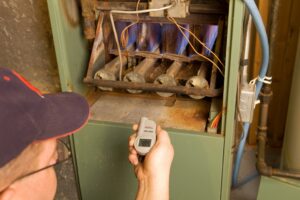Rust on furnaces is a common issue that homeowners may encounter, often causing concern about the health and efficiency of their heating systems. Let’s go over the various factors contributing to the development of rust on furnaces, the consequences of allowing rust to persist, and why replacement is a more viable option than attempting repairs. For all your heating services, rely on our team for an honest opinion on whether a rusty furnace is salvageable.
Why Is Rust Developing on My Furnace?
Moisture and Humidity: One of the primary catalysts for rust formation on furnaces is moisture. High humidity levels in the surrounding environment can accelerate the oxidation process, leading to the development of rust on metal surfaces. Common sources of moisture include water leaks, inadequate ventilation, or even condensation within the furnace itself.
Age and Wear: The age of a furnace plays a significant role in its susceptibility to rust. Over time, wear and tear can break down protective coatings on metal components, making them more prone to corrosion. Older furnaces that are past their 10-15-year lifespan, especially those without regular maintenance, are at a higher risk of rust-related issues.
Poor Maintenance Practices: Regular maintenance is crucial for preventing rust on furnaces. Neglecting routine cleaning and inspections allows dust, debris, and other contaminants to accumulate, creating an environment conducive to rust formation. Regular tune-ups not only extend the lifespan of the furnace but also help identify and address rust-related concerns before they escalate.
Exhaust Malfunctions: The role of your furnace’s exhaust system is vital within your HVAC system. It functions by expelling gases and hot air generated during the furnace operation, directing them outside to prevent their circulation within your home. If the exhaust system becomes obstructed or experiences damage, it can lead to the retention of excessive heat and gas. This trapped heat contributes to elevated moisture levels in the room, expediting the process of rust formation.
Safety First
Beyond affecting efficiency, rust can lead to structural damage in furnace components. Weakening of metal surfaces compromises the integrity of the entire heating system, posing potential safety hazards. If rust-related issues pose safety concerns, such as the risk of carbon monoxide leaks, immediate replacement is imperative to safeguard your household.
How Can I Prevent Rust Developing on My Furnace?
Regular Maintenance: Implementing regular cleaning and scheduling annual maintenance with our team can help identify and address rust at its early stages, preventing it from becoming a major problem.
Humidity Control: Controlling humidity levels in the furnace area is crucial. Installing dehumidifiers and addressing potential sources of moisture can significantly reduce the risk of rust formation.
Understanding the causes of rust on furnaces and being aware of the signs that indicate replacement is necessary can help homeowners make informed decisions about their heating systems. Prioritizing regular maintenance and prompt replacement when needed ensures a safe, efficient, and reliable furnace for the long term.
Serving Staten Island’s Heating and A/C needs since 1955. Contact the Bob Mims team to schedule an appointment for heating services in Staten Island today!


